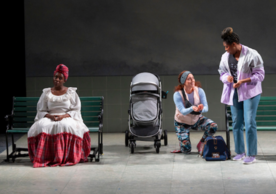
Stepping away from a classroom lab space for a packed theater house, the Yale School of Nursing (YSN) Simulation Team recently (figuratively) took the Yale Repertory Theatre stage for Marys Seacole, a production by students at the David Geffen School of Drama that draws inspiration from the life of Jamaican-Scottish nurse, businesswoman, and Florence Nightingale contemporary Mary Seacole.
Simulation Director Christine Rodriguez, DNP, APRN, FNP-BC, MDiv, MA was immediately drawn to the project and the opportunity engage with an atypical campus partner.
“It was a beautiful collaboration,” Rodriguez said. “The Simulation Team and the Drama Team met several times via Zoom to better understand the needs of the production, and we hosted an in-person tour for our School of Drama friends at YSN. We ultimately provided multiple pieces of equipment for the play, including a stretcher, a baby mannikin, and a vitals monitor.”
The play was written by Lecturer in Playwriting Jackie Sibblies Drury and directed by Leyla Levi ’23. The creative team of the sold-out run also includes Costume Designer T.F. Dubois, Lighting Designer Yichen Zhou ’24, Composer and Sound Designer Evdoxia Ragkou ’23, Technical Director Miguel Angel Lopez ’24, and Stage Manager Alexus Jade Coney ’24.
In her role as Production Dramaturg, Faith-Marie Zamblé ’23 drew on 19th century conceptions of race in Jamaica and the history of Western medicine to help frame the play’s material. But in addition to researching the life of Mary Seacole, she also had had the tricky job of thinking about how these facts intersected with Marys Seacole, which she described as “a play that is less interested in material reality than it is emotional and psychological truths.”
Zamblé described the experience of working with the YSN Simulation Team as both illuminating and humbling.
“There is an interesting parallel between what we do at the Drama School and what nursing students do in their coursework,” she said. “We are both attempting to respond to false circumstances with technical precision and emotional honesty. The difference is that in the case of Drama School, the stakes never become real. Money, reviews, and personal fulfillment are, of course, real, but with the exception of folks who build complex sets and hang delicate and dangerous equipment from the ceiling—shoutout to technical designers!—there is no real-world life or death scenario to prepare for. Nurses, on the other hand, may eventually have to save someone’s life or be put in situations that they’re not prepared for. Hearing about their training made me reflect on the fragility and unpredictability of the human body and gave me a real sense of the stakes behind simulations as a pedagogical tool.”
Scenic designer and third-year set design student B Entsminger ’24 said the pieces loaned from YSN helped the crew convey the visual story of the play much more effectively.
“I was so grateful to be able to incorporate actual medical equipment into the nursing home and nursing school scenes of Marys Seacole,” Entsminger said. “The stretcher and monitor both added a clear sense of reality to their scenes. Since the scenes all move between drastically different time periods and places the furniture and props were crucial in telling the story of those transitions.”
Both the YSN Simulation Team and Drama students expressed enthusiastic interest in collaborating on future projects.
Want More Mary Seacole?
Check out her autobiography “Wonderful Adventures of Mary Seacole in Many Lands,” originally published in 1857.
Want More Simulation?
Learn how the YSN Simulation Unit prepares for and executes a mass-casualty disaster simulation, an immersive cumulative assessment of everything nursing and midwifery students learn in their first year.
